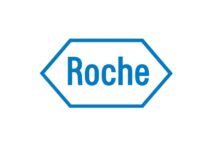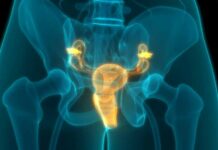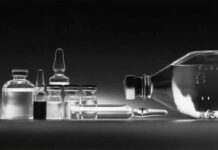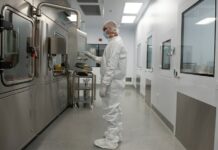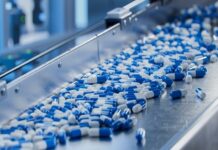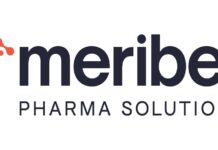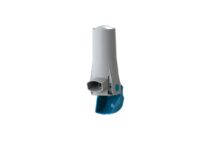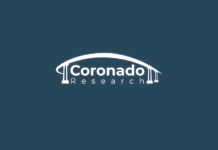The pharmaceutical water market is expected to grow at a compound annual growth rate (CAGR) of 9.3% from 2024 to 2034. It was valued at USD 39.85 billion in 2023 and is expected to reach USD 96.97 billion by 2033, according to Nova One Advisor. The market for pharmaceutical water was driven by the growing technical developments in this industry.
The market for highly purified water used in the pharmaceutical sector for equipment purification, sterilization, and cleaning, medication formulation, and other procedures is known as the pharmaceutical water market. Pharmacopoeia monographs state that pharmaceutical water cannot be used for pharmaceutical manufacture or processing unless it meets stringent quality requirements. For the quality, safety, and effectiveness of drugs, high-purity water is essential.
Over the course of the forecast period, the market is anticipated to rise as a result of the tightening regulations governing pharmaceutical water, the growing demand for biologics and generics, and the expanding pharmaceutical manufacturing sector. The product, type, region, and application segments make up the market. To assist guarantee that pharmaceutical businesses have access to dependable and high-quality water, major participants in the industry provide a variety of services, systems, and technologies.
Important Trends:
– Greater Focus on Water Recycling: To cut freshwater usage by 50% or more by 2030, major companies are investing in cutting-edge water treatment technologies.
– Emphasis on Point-of-Use Systems: In order to cut down on lengthy pipe networks, compact purifying devices placed close to industrial lines are becoming more and more common.
– The Emergence of Real-Time Monitoring: Cloud-based analytics and IoT sensors allow for continuous quality control and quicker reaction to contamination threats.
– Strategic M&A Activity: To expand their skills in areas like waste reduction and the manufacturing of ultrapure water, top suppliers are buying up water technology companies.
– Changing Regulations: More creative compliance solutions will be needed to meet the stricter regulations controlling wastewater discharge and recycling validation procedures.
Key Takeaways for the Pharmaceutical Water Market
- In 2023, North America had the largest market share (35.19%) in the world.
- From 2024 to 2033, Asia-Pacific is predicted to grow at the fastest CAGR of 10.3%.
- In 2023, the HPLC grade water segment is expected to have the largest revenue share (20.92%) among all segments.
- In terms of kind, the sector for water for injection is expected to grow at the quickest rate of 10.2% throughout the forecast period.
- In terms of application, the pharmaceutical and biotechnology firms segment had the largest market share in 2023 (58.14%), and over the forecast period, it is expected to grow at the quickest rate (10.3% CAGR).
- With a compound annual growth rate (CAGR) of 9.8% from 2024 to 2033, the size of the U.S. pharmaceutical water market, estimated at USD 7.19 billion in 2023, is expected to reach USD 18.31 billion by 2033.
- From 2024 to 2033, the Canadian pharmaceutical water market is projected to grow at a rate of 9.3% per year, giving the market a value of USD 4.49 billion in 2023.
- The pharmaceutical water market in Germany is projected to grow at a rate of 10.1% per year from 2024 to 2033. In 2023, it was worth USD 3.67 billion.
- By 2024, the size of the pharmaceutical water market in China is expected to reach USD 3.55 billion, with a compound annual growth rate (CAGR) of 11.3% until 2033.
Pharmaceutical Water Market: Global Expansion to Be Driven by Increasing Research
Pharmaceutical applications need careful consideration while choosing filtering techniques. In order to embrace alternate filtering techniques like reverse osmosis and nanofiltration, firms in this industry are stepping up their R&D efforts. Therefore, improved manufacturing techniques have helped to raise market demand.
The growing prevalence of diabetes among the elderly and obese, the rise in generic and biopharmaceutical injectable drug industries, the increasing emphasis of major players on the development and expansion of manufacturing facilities appropriate for generic formulations, and the increasing responsiveness for routine diagnosis and checkups are all anticipated to contribute to the growth of the pharmaceutical water market over the projected period.
Expanding Biopharmaceuticals and Biosimilars to Drive Market Growth
Recombinant proteins, monoclonal antibodies, cell and gene treatments, vaccines, and high-quality water meeting stringent purity criteria are all examples of biopharmaceuticals that depend on it throughout the production process. The market is expanding due to the growing number of licensed biosimilars, which are approved biologics’ biologic counterparts.
Pharmaceutical water is an essential raw material used in the production of biologics and biosimilars. The demand for pharmaceutical water is rising due to the notable growth in production capabilities and the growing biopharma industry. Therefore, throughout the course of the forecast period, these driving variables are anticipated to augment the expansion of the pharmaceutical water market.
Nonetheless, Product Recalls in Pharmaceutical Water Could Limit Market Expansion.
Concerns about product recalls have impeded the pharmaceutical water market’s expansion, which is vital for the manufacturing of medical supplies and medication solutions. Since pharmaceutical water serves as both a raw material and a medium formulation throughout the drug-making process, any contamination or impurity in the quality of the water might have a detrimental effect on the final product’s safety and effectiveness. Therefore, throughout the projected period, these factors are anticipated to limit the expansion of the pharmaceutical water market.
Expanding Need in Emerging Markets to Transform Market Expansion
Significant potential prospects are presented by the pharmaceutical water industry to growing nations like China, India, and others. These nations have the fastest-growing pharmaceutical industries due to their expansion in the production of generic drugs, improvements in healthcare accessibility, infrastructure investments in research and development, and sizable biotechnology sectors. To meet rising export and domestic demand, pharmaceutical businesses, both local and multinational, are building new facilities in expanding markets. Pharmaceutical water purification systems will become more widely used as a result, and producers will have a lot of opportunity to expand. Therefore, in the upcoming years, these factors are anticipated to augment the expansion of the pharmaceutical water market.
Asia Pacific is expected to increase at the quickest pace throughout the projection period.
The market for pharmaceutical water is expected to develop due to rising healthcare costs, rising pharmaceutical production, and rising investments in the pharmaceutical water sector. The leading nations in the market are South Korea, Japan, China, and India. China is thought to be the market’s fastest-growing rising nation. India is another country with notable market growth.
- As an example, Veolia Water technology, a division of Veolia and a preeminent authority on water treatment technology and services, announced in May 2024 the opening of its first ion exchange regeneration plant in China. Utilizing cutting edge technology, the plant effectively recycles wasted ion exchange resins while advancing resource efficiency and sustainability.
In 2023, the pharmaceutical water market was dominated by North America.
The robust regulatory environment, expanding pharmaceutical sector, and expanding well-established pharmaceutical industry are the main factors driving the development of the pharmaceutical water market in North America. The two dominant nations in the area are the United States and Canada. North America is the leader in pharmaceutical manufacturing services, strict laws, and pharmaceutical water standards of the highest caliber.
- For example, Veolia Water Technologies introduced the most recent version of Polaris in the US in February 2024. It is a water distillation and high-capacity steam production system that was created especially for the pharmaceutical sector. Using a variety of standard options, the skid-mounted PolarisTM 2.0 Pure Steam Generator (PSG) systems and PoIarisTM 2.0 Multiple Effect Distiller (MED) have been engineered to deliver the necessary volumes of water for injection with reliability and to produce pure steam in accordance with European, Japanese, and US Pharmacopoeia standards.
Market Segments for Pharmaceutical Water
The Pharmaceutical and Biotechnology Companies Segment Led the Market by Application Type
In 2023, the category of pharmaceutical and biotechnology firms had the greatest market share. A vital component in the production of pharmaceuticals is pharmaceutical water. These goods are used in quality assurance, cleaning, and formulation, among other manufacturing processes. The infrastructure, resources, and experience of biotechnology and pharmaceutical businesses allow them to guarantee pharmaceutical water of the highest quality and to meet these regulatory requirements.
In 2023, the pharmaceutical water market was led by the water for injection segment. In pharmaceutical production processes, water is an essential component for the injection segment, particularly for creating parenteral medications like sterile solutions, infusions, and injectables. Regulators maintain strict quality requirements for WFI in order to guarantee the effectiveness and safety of the product.
Significant Advancements in the Pharmaceutical Water Industry
- Asahi Kasei said in June 2024 that it has started offering a membrane technology for producing injectable water in Germany. It was a particular kind of sterile water used in injection manufacturing. The membrane system was created as an alternative to the traditional distillation procedures for the manufacture of WFI by using the system design and development capabilities of MicrozaTM hollow-fiber membrane for water treatment and liquid product filtering. This technique reduces the requirement to create steam, which results in reduced CO2 emissions and cheaper production costs for WFI.
- DataShare Elite for Sievers Total Organic Carbon (TOC) Analyzers is a new data management software platform that was introduced by Water Technologies and Solutions, SUEZ, in July 2022. DataShare Elite consolidated TOC and conductivity data from several sources, enabling quicker and better decision-making while upholding data integrity and compliance standards.
- In March 2023, the Alter Pharma Group and its subsidiary Milla Pharmaceuticals Inc. announced the introduction of a Generic Version of Magnesium Sulfate by Their Partner Athenex Pharmaceutical Division (APD) in non-invasive, water for injection, and single patient-use containers.
Segmentation of the Pharmaceutical Water Market Report
In addition to providing an analysis of current industry trends in each of the sub-segments from 2021 to 2033, this paper anticipates revenue growth at the national level. Nova One Advisor, Inc. has divided the Pharmaceutical Water market into segments for its analysis.



